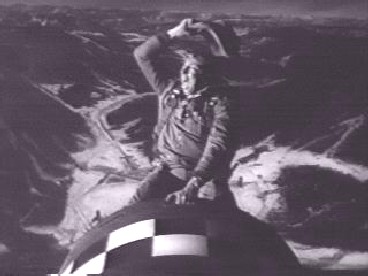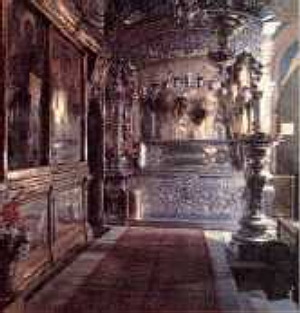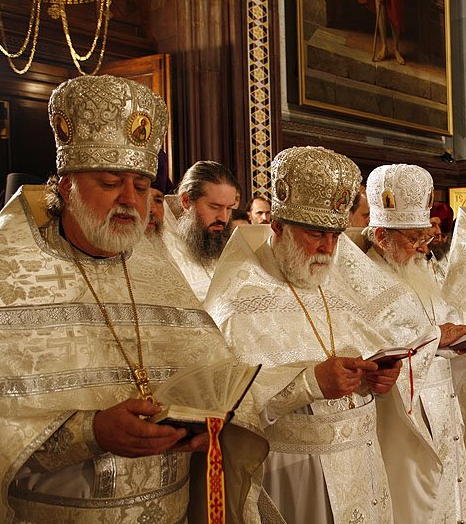
The Kremlin
We headed out early again to the Kremlin for the final service of our vist at the Uspensky (Dormition) Cathedral.
This Church was where the Tsars, beginning with Ivan the Terrible, were crown, and where the Tsars often went to Church. The frescoes on the inside of the Church are very old, and beautiful. I wasn't serving this time, and so I just stood with the people. Initially I was in the middle of the Church with some other clergy, but an MP priest saw us and waved for us to move to the front of the Church, and so we had a very good view of the rest of the service.
You can see photos of this service by clicking here.
You can see a photo showing where I was (just behind the analogion to the left) by clicking here.
Here is a more close up shot of where I was.
You can see a high resolution photo of one of the walls of the Cathedral by clicking here.
And you can see a high resolution photo of more of the interior here.
As I said the place were I stood for most of the service afforded a good view, however, when it came time for the communion of the faithful, there was a press of people trying to get in position to receive communion from the patriarch that was a bit more than I was used to. I was knocked off balance a few times, but didn't fall because I was sandwiched in fairly well. I started to inch my way to a stone booth to my right, which I think was probably where the Tsar used to sit for the service. I figured I wouldn't be crushed there... and after a lot of squeezing, I made it there.
At the end of the service, I was able to go into the altar and venerate the relics of the holy hierarchs Phillip and Peter of Moscow. I later found out that I had missed the opportunity to venerate the relics of the holy hierarchs Hermogenes and Jonah of Moscow, whose relics are in other parts of the Church.
You can see more photos of this service by clicking here.
After the service, there was some confusion about how much time we would have to tour the Kremlin. Originally, we were supposed to have about 3 hours after the liturgy. However, in the morning we were told that the buses would be leaving much earlier than originally planned. After the service, I caught one of the organizers of the trip, and before he could explain, he just said "go to the buses", and then was whisked away with the official delegation. I wasn't happy about it, but I went to were the buses were supposed to be, but they were no where to be seen. Fr. Nicholas Manduke and I decided that we were going to make a run to Red Square, because the one landmark in Russia that everyone knows is St. Basil's Cathedral, and I did not want to come this close to it without being able to see it.
We figured the buses would not be able to load before we would be back, and in a worse case scenario, we would take a cab. So off we went, at a brisk pace. Red Square is amazing all by itself, but it is not as big as you might think from having watched the parades of ICBM's during the Soviet period. And by the way, Red Square's name has nothing to do with the Communists. It was called Red Square long before they came and went. The Russian word for "red" also means beautiful.
On the way to St. Basil's, we had to walk past Lenin's tomb. Fr. Leonid Mickle told me two interesting things about it. First, he cited a Russian saying that "A saint is known by his myrrh". And then told of how once a sewer line broke in the Kremlin, which resulted in Lenin floating in sewage. He then told me that a writer (whose name escapes me) from the Soviet period, who always danced close to the edge of acceptability to the Soviets once suggested that since Lenin had requested to be buried next to his mother, that his wish should be granted, and that this would free up a wonderful location for a restroom, of which there is a notable lack in the Red Square area.
The closer we got to St. Basil's, the more beautiful it appeared. It is more beautiful than the pictures I had seen led me to expect. We would have had to buy tickets to go inside. I am told that it is not as impressive on the inside as the outside might suggest, and it is not a big Church, but rather a series of small chapels. However, had I known we had the time, I would have gone inside. As it was, we just walked around it to get a good look at it from the outside. It was more than worth the trip.
We then headed back. On the way, we stopped at a Sbarro's Pizza, and for not too many rubles, I had a slice of pizza that hit the spot.
When we we got back, we discovered that we actually had about 30 more minutes before the buses would be there. Oh well.
While waiting for the bus a man came up to me and said that he was from Mexico, and wanted to know if he could have his picture taken with me. I obliged, but thought it was funny that he had come all the way to Moscow to have his picture taken with a Tejano in front of the Kremlin.
At some point, Fr. Leonid Mickle, who had been to Moscow during the Soviet period commented on how happy it made him to see the Russian Flag flying over the Kremlin, rather than the Hammer and Sickle. Flying over the presidential palace is the presidential flag, which has the double-headed eagle of the Russian Empire.
We went back to the hotel, and then that evening we went to a banquet that was hosted by some members of ROCOR who were living in Moscow. It was a very impressive meal... probably the best one we had, although since there were not many MP clergy present, the toasts seemed to lack some of the zip I had gotten used to. I spent the evening visiting with people whom I would soon be missing until the next big shindig would bring us together again.
Click here for a photo of Steve Pennings and myself at the banquet.
Around 9:30, I took the earlier bus back to the hotel to rest, and prepare for the trip home.
Day 8, Monday, May 21st.
This day happened to be my name's day, the feast of St. John the Theologian, and while travelling is not what I normally would have picked to be doing on this day, I took some consolation from the fact that it would be the longest name's day I would probably ever have, since we would be flying with the rotation of the earth, and so the day would be 33 hours long. We had a long bus ride back to the airport, but for some reason -- guilt perhaps -- the bus driver had the A/C on at last.
We had to go through Russian customs... Russia being one of the few countries that does this on the way out, because they want to make sure you are not smuggling out historical artifacts. We had a long wait for our plane, and so we were able to do some last minute shopping in the duty free area.
Click here for one of many group photos taken while we waited.
As the plane lifted off, we sang the troparion of the feast of the Ascension. Yet another Aeroflot crew was in for an experience. It was daylight the entire flight back to New York, and there was an even more festive atmosphere than there was on the way to Moscow. The flight went by relatively quickly thanks to the wonderful conversations we were all having on the way.
When we finally made it to JFK airport, and got in line to go through American customs, there was a joy that Americans were finally organizing a line for us again. It went so smoothly, that we were all quite happy to be back in America. All too quickly, we went our separate ways, but all with a lot of joyous memories of what we had seen and done, and of each other.
I still had my two parishioners with me on the flight to Houston. Click here for a photo of the weary tres hombres, Steve Pennings, George Nahlous, and myself. I was calling my wife for the first time in a week, having been absent on her birthday. George was checking on the status of his chickens and garden, and Steve was busy capturing the moment.
To my surprise, on the flight back I was able to catch the season finale of 24. We made it into Houston at 11:00 p.m., and I finally made it home at 1:00 a.m. the following day, very tired, but happy to have been blessed to be on this historic trip.




















